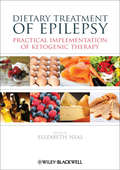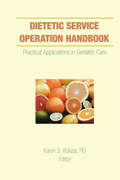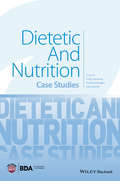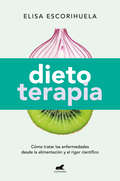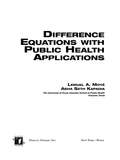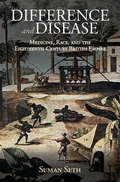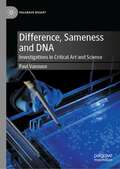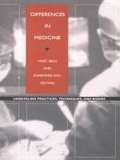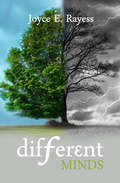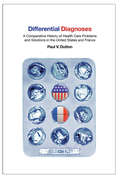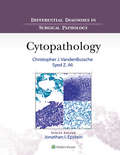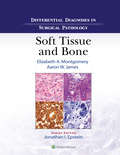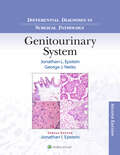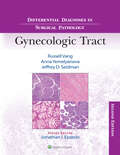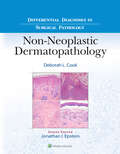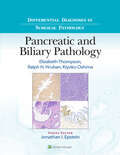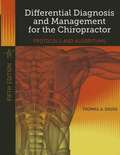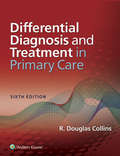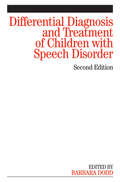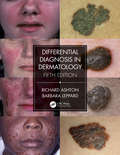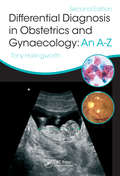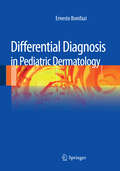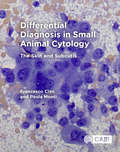- Table View
- List View
Dietary Supplements of Plant Origin: A Nutrition and Health Approach
by Massimo MaffeiDietary supplements are estimated to be used regularly by almost 60% of the American population, and over 300 million people worldwide. An important and ever-growing portion of this market is in botanical supplements that are derived from natural plants. Natural, however, does not necessarily mean safe, and although plants can provide health-essent
Dietary Treatment of Epilepsy
by Elizabeth NealEpilepsy is a common chronic neurological disorder characterised by recurrent unprovoked seizures, and affects 50 million people worldwide. Approximately 30% of these do not have seizure control even with the best available medications, hence renewed and increasing interest in the use of dietary treatments to treat epilepsy. These treatments include the traditional ketogenic diets but also the newer modified Atkins diet and low glycaemic index treatment. The ketogenic diet is a high-fat, adequate-protein, low-carbohydrate diet that in medicine is used primarily to treat refractory epilepsy in children, and requires the dedicated support of a multi-disciplinary team including doctors and dietitians. Dietary Treatment of Epilepsy: Practical Implementation of Ketogenic Therapy provides comprehensive and practical training on all aspects of implementing and managing dietary treatments for epilepsy, with key chapters on assessment, calculations, implementation, monitoring and complications. Edited by a highly respected expert in the field supported by a strong team of contributors, this is a must-have resource for paediatric dietitians and other members of the therapy team.
Dietas que Sanan: Dietas que Curan Cómo Curar Enfermedades y Dolencias para Estar más Sano
by Doug FredrickDietas que curan por Doug Fredrick Cómo curar enfermedades y dolencias para estar más sano, bajar de peso y reducir el dolor Cómo curar enfermedades y dolencias para estar más sano, bajar de peso y reducir el dolor Dietas Que Curan ¿Sufre de dolor crónico, enfermedad o una enfermedad debilitante? Si es así, entonces este libro podría ayudarle a sentirte mejor que nunca. Introduciendo técnicas secretas que los profesionales de la salud han estado utilizando durante décadas. ¡Este libro electrónico le mostrará la manera más rápida y efectiva de usar la curación natural para beneficiar su bienestar! Usted aprenderá a aumentar su bienestar en tan sólo unas semanas. No sólo eso, sino que mejorará literalmente todos y cada uno de los aspectos de su vida. - Combatir enfermedades crónicas - Bajar de peso - Superar las dolencias - Curarse a si mismo - Sentirse mejor que nunca - Cómo obtener una nutrición adecuada para ayudar a su curación + ¡MUCHO MÁS! ¡Desplácese hasta la parte superior de la página para acceder instantáneamente! Descargo de responsabilidad: Este autor y/o propietario(s) de derechos no hace reclamos, promesas o garantías con respecto a la exactitud, integridad o adecuación del contenido de este libro, y expresamente niega responsabilidad por errores y omisiones en el contenido de este libro. Este producto es sólo para uso de referencia. Por favor, consulte a un profesional antes de tomar acción sobre cualquiera de los contenidos que se encuentran dentro.
Dietetic Service Operation Handbook: Practical Applications in Geriatric Care
by Karen KolasaApproved by the Dietary Managers Association for 9 CEUs. Here is a useful guide that helps both administrators and food service workers understand the daily functions of their dietary departments. Dietetic Service Operation Handbook enhances extended caregivers’knowledge of basic food service and clinical dietetics operations and serves as a functional tool they can use to initiate effective organization of dietetic services. It explains proper techniques and tips for everything from how to plan a menu and care for equipment to special adaptive eating devices and modifying texture for swallowing disorders. Packed with general and specific guidelines, this book also teaches food service employees how to allocate time more wisely, making them effective members of the interdisciplinary medical team--and saving their facility time and money as well. Administrators who wish to understand the functions of their dietary department so they can communicate more effectively with its staff will find this book a most useful resource, full of meaningful interpretations of routine tasks found in the daily operation of a food service.The author, registered with the American Dietetic Association, has prioritized the topics in the book to assist the systematic organization of any dietary department. Chapters cover both administrative and clinical topics, including food purchasing and production, the policy and procedure manual, quality assurance, current trends in geriatric nutrition, the effects of medicine on diet, enteral feeding, and documentation of the medical record. Dietetic Service Operation Handbook includes a wide variety of standardized recipes for the pureed diet, a resource list, handy calculations, and many useful forms for record-keeping which are compatible with OBRA laws. Beginning dietitians and dietary managers will find this book to be an extremely helpful and practical guide in their day-to-day
Dietetic and Nutrition Case Studies
by Joan Gandy Judy Lawrence Pauline DouglasThe ideal companion resource to 'Manual of Dietetic Practice', this book takes a problem-based learning approach to dietetics and nutrition with cases written and peer reviewed by registered dietitians, drawing on their own experiences and specialist knowledge Each case study follows the Process for Nutrition and Dietetic Practice published by the British Dietetic Association in 2012 Includes case studies in public health, an increasingly important area of practice
Dietoterapia
by Elisa EscorihuelaEl método que nos demuestra que comer bien es la mejor medicina. La alimentación es una parte fundamental de nuestro día a día. Lo que comemos y lo que dejamos de comer tienen una incidencia esencial en nuestra salud y nuestro desarrollo físico. Tanto es así que a través suyo podemos prevenir e incluso ayudar en el tratamiento de algunas enfermedades. Esta práctica es lo que se conoce como dietoterapia. La dietoterapia no ofrece nada parecido a dietas milagrosas: se trata de una aproximación estrictamente científica que relaciona los componentes nutricionales con causas y síntomas. Afecciones tan comunes como las intolerancias, las alergias, la diabetes, el colesterol, la endometriosis y la hipertensión arterial pueden combatirse en parte gracias al conocimiento y la práctica de hábitos alimenticios específicamente pensados para ello. Así, a través de los consejos y las recetas y menús semanales que nos propone la dietista y farmacéutica Elisa Escorihuela, aprenderemos a cuidar de nuestra salud de una forma específica y natural. Reseña:«Si somos lo que comemos, con este libro aprenderás a ser tú, sin aditivos ni artificios.»Dr. Julio Mayol
Difference Equations with Public Health Applications (Chapman & Hall/CRC Biostatistics Series)
by Asha Seth Kapadia Lemuel A. MoyéThis study of difference equations with public health applications develops the methodology for the solution of the general kth order linear difference equation using the generating function approach. It includes an examination of the dynamics of disease spread and containment in populations using illness-death models. There are over 1000 featured
Difference and Disease: Medicine, Race, and the Eighteenth-Century British Empire (Global Health Histories)
by Suman SethDifference, Sameness and DNA: Investigations in Critical Art and Science (Palgrave BioArt)
by Paul VanouseThis book chronicles over two decades of critical, artistic investigations by Paul Vanouse. His bio-media artwork utilizes the tools of the life sciences reflexively, to challenge tropes and cultural politics surrounding DNA, biotechnology, and life itself. DNA has been called a “Truth Machine”, “God’s Blueprint”, the “Code of Codes” and the “Book of Life”. Vanouse’s work explores questions at the heart of such evocative metaphor and hyperbole: how does DNA link us together, how does it differentiate us and how are the grand metaphors, which grant DNA complete centrality, misconstruing the complexity of life. Furthermore, how do technologies of genetic typing and identification fit within a broader cultural and political history of difference making, particularly the construction of race. Melding critical theory, artist’s manifesto, participatory observation and histories of the sciences, this book offers insight into both an artistic practice and the bio-techno-sciences it interrogates.
Differences in Medicine: Unraveling Practices, Techniques, and Bodies
by Annemarie Mol Marc BergWestern medicine--especially in contrast with non-Western traditions of medical practice--is widely thought of as a coherent and unified field in which beliefs, definitions, and judgments are shared. Marc Berg and Annemarie Mol debunk this myth with an interdisciplinary and intercultural collection of essays that reveals the significantly varied ways practitioners of "conventional" Western medicine handle bodies, study test results, configure statistics, and converse with patients .Combining theoretical work with interviews and direct observation of the activities and interactions of doctors, nurses, technicians, and patients, the contributors to this volume provide comparative studies of specific cases. Individual chapters explore topics such as the contested domain of fetal surgery in a California hospital, the construction of gender identity before transsexual surgery in Germany, and differences in the treatment and definition of pain by two clinics in France. Differences in Medicine advances earlier studies on medicine's social diversity and regional variations to expose significant differences in the presumptions and decisions that affect patients' lives, and marks a dramatic development in both the study of medicine and in science studies generally.Revealing the ways in which the bodies and lives of people are constructed as medical objects by practitioners, technologies, and textbooks, this collection calls for and initiates new, more textured investigations and theories of the body in medicine and the practice of science. It will open new discussions among medical and healthcare professionals as well as scholars in medical anthropology, science studies, sociology, philosophy, and the history of medicine.Contributors. Isabelle Baszanger, Marc Berg, Geoffrey C. Bowker, Monica J. Casper, Charis M. Cussins, Nicolas Dodier, Stefan Hirschauer, Annemarie Mol, Vicky Singleton, Susan Leigh Star, Stefan Timmermans, Dick Willems
Different Minds
by Joyce E. RayessMagic realism, science fiction, and romance converge in a Lebanese author&’s novel about a woman&’s journey of the heart, mind, and soul. Cassandra Kelly is still grappling with her mother&’s death. Attending university has only made it more difficult for the shy and withdrawn Cassandra to cope. She&’s ridiculed by one male student, and all but invisible to the man she desires from afar. Then, Cassandra&’s life takes a startling turn—when she plans to ends it. Just as astonishing, a woman named Julie suddenly awakens from a coma. Cassandra awakens, too. But now Cassandra is seeing the world in a whole new light. Through the eyes of a stranger. Two souls have melded. For Cassandra, two lives must be led. With her own mind and memories, she&’s living in Julie&’s world now. And it comes with Julie&’s problems, including an impending marriage to the one man Cassandra can&’t abide. What unbelievable secrets must she hide? And which must she surrender to find the true love she&’s lived two lifetimes to call her own?
Differential Diagnoses
by Paul V. DuttonAlthough the United States spends 16 percent of its gross domestic product on health care, more than 46 million people have no insurance coverage, while one in four Americans report difficulty paying for medical care. Indeed, the U. S. health care system, despite being the most expensive health care system in the world, ranked thirty-seventh in a comprehensive World Health Organization report. With health care spending only expected to increase, Americans are again debating new ideas for expanding coverage and cutting costs. According to the historian Paul V. Dutton, Americans should look to France, whose health care system captured the World Health Organization's number-one spot. In Differential Diagnoses, Dutton debunks a common misconception among Americans that European health care systems are essentially similar to each other and vastly different from U. S. health care. In fact, the Americans and the French both distrust "socialized medicine. " Both peoples cherish patient choice, independent physicians, medical practice freedoms, and private insurers in a qualitatively different way than the Canadians, the British, and many others. The United States and France have struggled with the same ideals of liberty and equality, but one country followed a path that led to universal health insurance; the other embraced private insurers and has only guaranteed coverage for the elderly and the very poor. How has France reconciled the competing ideals of individual liberty and social equality to assure universal coverage while protecting patient and practitioner freedoms? What can Americans learn from the French experience, and what can the French learn from the U. S. example? Differential Diagnoses answers these questions by comparing how employers, labor unions, insurers, political groups, the state, and medical professionals have shaped their nations' health care systems from the early years of the twentieth century to the present day.
Differential Diagnoses in Surgical Pathology: A Clinician's Guide To Addressing Vaccine Hesitancy And Saving Lives
by Syed Ali Christopher J. VandenBusscheFor a concise, image-heavy guide to making accurate diagnoses from a range of cytopathology specimens, choose Differential Diagnoses in Surgical Pathology: Cytopathology, the latest addition to the renowned series. Compare similar entities—or those with many common attributes—and learn to spot the elements and details that can impact diagnosis. Like other volumes in the series the book presents material in a way that pathologists actually work, and is ideal as a quick-reference guide or for deep-dive research.
Differential Diagnoses in Surgical Pathology: Differential Diagnoses In Surgical Pathology
by Aaron James Elizabeth A. MontgomeryNew in the Differential Diagnosis in Surgical Pathology series, this abundantly illustrated title helps you systematically solve tough diagnostic challenges in soft tissue and bone pathology. It uses select images of clinical and pathological findings, together with succinct, expert instructions and diagnostic pearls, to guide you through the decision-making process by distinguishing between commonly confused lesions of soft tissue and bone. By presenting material according to the way pathologists actually work, this user-friendly volume helps you quickly differentiate entities that have overlapping morphologic features.
Differential Diagnoses in Surgical Pathology: Genitourinary System
by Jonathan Epstein George J NettoOffering expert, practical guidance through the decision-making process, Differential Diagnoses in Surgical Pathology: Genitourinary System, by Drs. Jonathan I. Epstein and George J. Netto, covers more than 175 differential diagnoses, ranging from the most common to the less frequently seen. In every chapter of this new second edition, lesions are presented side by side for easy comparison, with clinical and pathological findings in short outline format followed by several full-color images. In addition to illustrating and discussing the classical features of these entities, the authors emphasize atypical features that can complicate diagnoses.
Differential Diagnoses in Surgical Pathology: Gynecologic Tract
by Russell Vang Anna Yemelyanova Jeffrey D. SeidmanOffering expert, practical guidance through the decision-making process,Differential Diagnoses in Surgical Pathology: Gynecologic Tract, Second Edition, by Drs. Russell Vang, Anna Yemelyanova, and Jeffrey D. Seidman, helps you systematically solve tough diagnostic challenges in gynecologic pathology and arrive at a correct diagnosis between commonly confused entities. In this fully revised edition, lesions are presented side by side for easy comparison, with clinical and pathological findings in short outline format followed by several full-color images. In addition to illustrating and discussing the classical features of these entities, the authors emphasize atypical features that can complicate diagnoses.
Differential Diagnoses in Surgical Pathology: Non-Neoplastic Dermatopathology
by Deborah CookOffering expert, practical guidance through the decision-making process, Differential Diagnoses in Surgical Pathology: Non-Neoplastic Dermatopathology, by Dr. Deborah L. Cook, helps you systematically solve tough diagnostic challenges in skin pathology and arrive at a correct diagnosis between commonly confused entities. In this all-new title, lesions are presented side by side for easy comparison, with clinical and pathological findings in short outline format followed by several full-color images. In addition to illustrating and discussing the classical features of these entities, the author emphasizes atypical features that can complicate diagnoses.
Differential Diagnoses in Surgical Pathology: Pancreatic and Biliary Pathology
by Elizabeth Thompson Ralph H Hruban Kiyoko OshimaNew in the Differential Diagnosis in Surgical Pathology series, this abundantly illustrated title helps you systematically solve tough diagnostic challenges in pancreatic and biliary pathology. It uses select images of clinical and pathological findings, together with succinct, expert instructions and diagnostic pearls, to guide you through the decision-making process. By presenting material according to the way pathologists actually work, this user-friendly volume helps you quickly differentiate commonly confused entities that have overlapping morphologic features.
Differential Diagnosis and Management for the Chiropractor: Protocols and Algorithms
by Thomas A. SouzaThe Fifth Edition of this best-selling reference is a compendium of evidence-based approaches to the most common presenting complaints. Covering both musculoskeletal and visceral complaints, this text is intended to direct the chiropractor toward an appropriate plan of approach in both diagnostic evaluation and care. Highlighting these approaches are flowcharts (algorithms), relevant historical questioning, and summaries of common conditions related to the presenting complaint. What's New in the 5th Edition?* Additional disorders added to Selected Causes at the conclusion of chapters* Addition of Likelihood Ratio graphics * Addition of approximately 500 new references * New Appendix: Evidence Based Approach to the Literature* Expanded Appendix: Pharmacology for the Chiropractor includes newer drugs and further explains the classifications of medications mechanisms* Translation into Practice Summary (TIPS) for most of the orthopedic chapters* Updated Algorithms: Cervical spine, Lumbar spine, Shoulder, Knee
Differential Diagnosis and Treatment in Primary Care
by R. Douglas CollinsFor more than three decades, Differential Diagnosis and Treatment in Primary Carehas helped primary care practitioners to systematically approach the differential diagnosis of the symptoms and signs they see in practice. Organized into categories such as pain, mass, bloody discharge, non-bloody discharge, functional changes, and abnormal laboratory results, this bestselling clinical reference helps you apply your basis science knowledge to consider all of the possible causes of each symptom, and then take the appropriate steps to determine which one is most likely. Apply the latest knowledge due to comprehensive updates throughout the text, including new signs and symptoms, new and expanded case histories, updated diagnostic tests, and more. Interact with patients more effectively with a new section on bedside manner, and get therapeutic guidance from a new section on the treatment of common diseases. Know what to look for thanks to abundant anatomical drawings that highlight relevant features in each body area. Develop your diagnostic skills with cases and clinical questions for each sign or symptom, as well as the framework for thinking through those questions to arrive at the appropriate diagnosis. Select the appropriate diagnostic procedures and laboratory tests to include in the workup. Recognize when to refer a patient to a specialist with a special section on this topic.
Differential Diagnosis and Treatment of Children with Speech Disorder
by Barbara DoddPaediatric speech and language therapists are challenged by diminished resources and increasingly complex caseloads. The new edition addresses their concerns. Norms for speech development are given, differentiating between the emergence of the ability to produce speech sounds (articulation) and typical developmental error patterns (phonology). The incidence of speech disorders is described for one UK service providing crucial information for service management. The efficacy of service provision is evaluated to show that differential diagnosis and treatment is effective for children with disordered speech. Exploration of that data provides implications for prioritising case loads. The relationship between speech and language disorders is examined in the context of clinical decisions about what to target in therapy. New chapters provide detailed intervention programmes for subgroups of speech disorder: delayed development, use of atypical error patterns, inconsistent errors and development verbal dyspraxia. The final section of the book deals with special populations: children with cognitive impairment, hearing and auditory processing difficulties. The needs of clinicians working with bilingual populations are discussed and ways of intervention described. The final chapter examines the relationship between spoken and written disorders of phonology.
Differential Diagnosis in Dermatology
by Richard Ashton Barbara LeppardDIFFERENTIAL DIAGNOSIS IN DERMATOLOGY Fifth Edition RICHARD ASHTON, MA, MD, FRCP, Consultant Dermatologist, Lighthouse Clinic, Isle of Wight, UK, formerly Consultant Dermatologist to the Royal Navy BARBARA LEPPARD, DM, FRCP, Retired Consultant Dermatologist, Southampton University NHS Trust, UK The ethos of this bestselling text is that however much or little you know about skin disease you can always arrive at the right diagnosis. The secret is to examine the surface of the rash or skin lesion which will help you classify the clinical features correctly - colour, surface features, type of lesion, border and how long it has been present. Algorithms throughout each chapter give the differential diagnosis for the features you have elicited. Accompanying clinical photographs and clear descriptions of the conditions will enable you to check whether you are right or not. If your choice seems unlikely, any conditions that could be confused with the one you selected are listed along the base of the algorithm to help you compare diagnoses so that you can get to the right answer. We hope this new edition - enhanced with specific instructions on treatment - will be the only quick clinical reference you will ever need for dermatology diagnoses. With over 1000 illustrations.
Differential Diagnosis in Obstetrics & Gynaecology: An A-Z, Second Edition
by Tony HollingworthOne of the major challenges in obstetrics and gynaecology is the need for a broad knowledge of medicine and surgery as well as the conditions specific to reproduction. The comprehensive nature of Differential Diagnosis in Obstetrics and Gynaecology achieves this goal.The book provides clinicians with invaluable assistance in the diagnostic process
Differential Diagnosis in Pediatric Dermatology
by Ernesto BonifaziThis book is devoted exclusively to differential diagnosis in pediatric dermatology. It covers the full range of relevant conditions: inherited skin disorders; nevi; viral, bacterial, fungal, and parasitic infections; acne; allergic diseases; autoimmune skin disorders; connective tissue diseases; tumors; and miscellaneous conditions. Each comparison addresses the differential diagnosis between two (or occasionally three or four) dermatological conditions, containing between two and six images and a short text emphasizing the clinical differences between the diseases in question. At the end of each chapter, a summary highlights one or two characteristics essential for the differential diagnosis. The author is an expert who, since 1982, has been responsible for a column devoted to the differential diagnosis of pediatric dermatology in the European Journal of Pediatric Dermatology. The volume will represent an ideal tool for pediatric dermatologists, pediatricians, and GPs, and will help them in the diagnostic process.
Differential Diagnosis in Small Animal Cytology: The Skin and Subcutis
by Francesco Cian Paola MontiIllustrated with high-quality photomicrographs, Differential Diagnosis in Small Animal Cytology: The Skin and Subcutis is a comprehensive resource for identifying through cytology the most common cutaneous and subcutaneous diseases of dogs and cats. With key points describing the main clinical and cytological features of each lesion, the book provides lists of differential diagnoses, including diagnostic algorithms, and handy 'hints and tips' boxes. It is also enriched by chapters on the correct use and maintenance of the microscope, and techniques of collection and preparation of cytological specimens, making the book a valuable resource for veterinary pathologists (clinical and anatomic), residents, veterinary undergraduate students and small animal practitioners. Key features: -Over 130 photomicrographs of the most common skin and subcutaneous lesions to help with diagnosis. -Ideal reference book with concise descriptions of each lesion. -Organised into key bullet points to facilitate use during diagnostic work, or as a revision aid.

